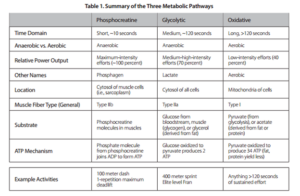Time to get all nerdy on you guys. You know there has to be some science behind this thing called “FITNESS”.
Let’s talk about “Energy”. Our bodies need energy to perform all the things we do 24/7, 365. Even when we sleep, our bodies need to utilize energy to keep the heart beating and lungs breathing.
The body acquires this energy through three pathways.
These pathways are “metabolic engines” known as the phosphagen pathway, the glycolytic pathway, and the oxidative pathway. The table below shows the differences between each pathway.
Our activities require us to use all three of these pathways at the same time, however one pathway is being used to a greater degree than the others depending on the activity.
The first pathway, the phosphagen, is the pathway used to provide energy during the highest-powered activities, those that last less than about 10 
The second pathway, the glycolytic, is utilized more during moderate-powered activities, those that last up to several minutes IE: 400m sprint or sub 4 min Fran.
The third pathway, the oxidative, dominates low-powered activities, those that last in excess of several minutes IE: 800m run, 5k run, 10 min AMRAP or marathons.

Two of the most common mistakes when training is focusing on just one or two of the pathways while excluding the others and not recognizing the impact of only training excessively in the oxidative pathway (long duration) and neglecting the phosphagen pathway (sprint-style work).



